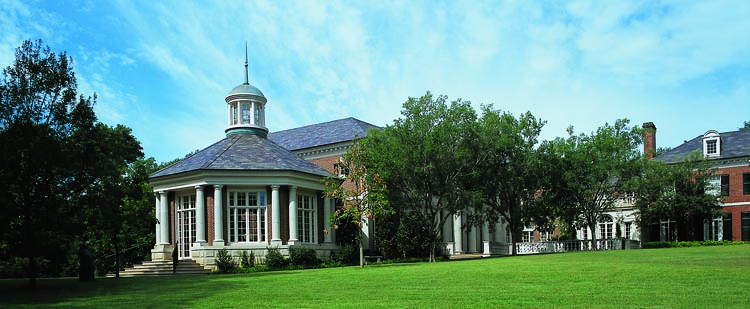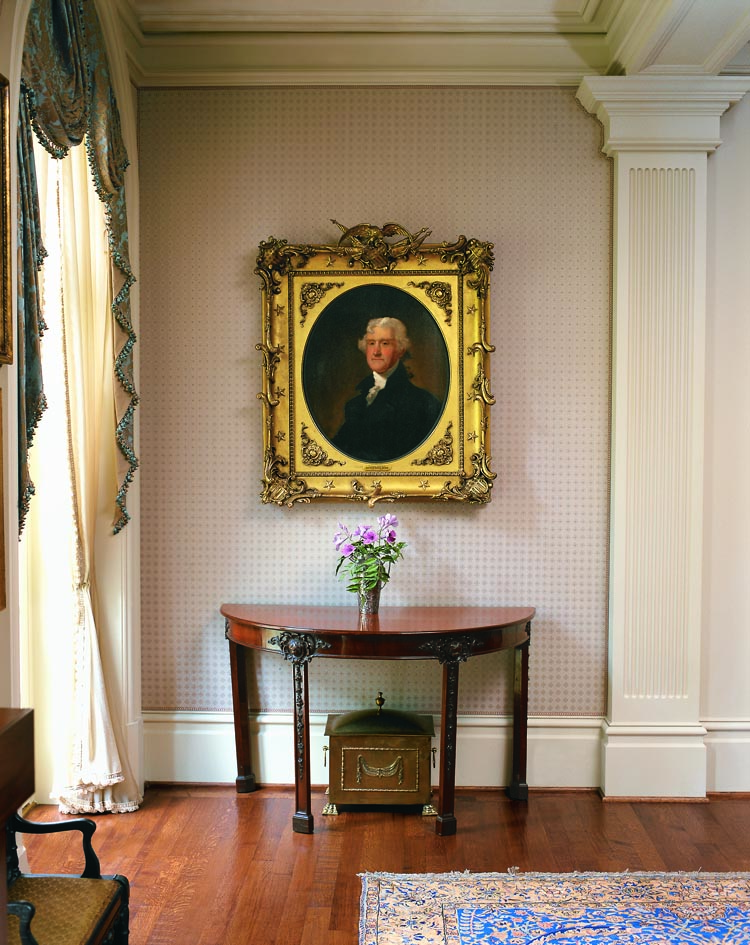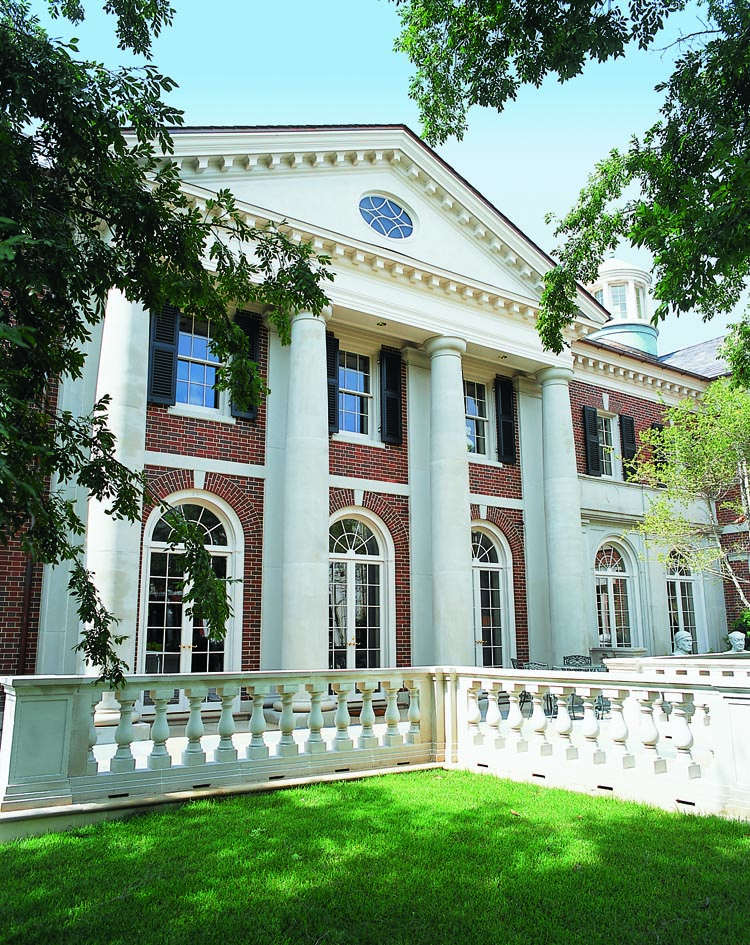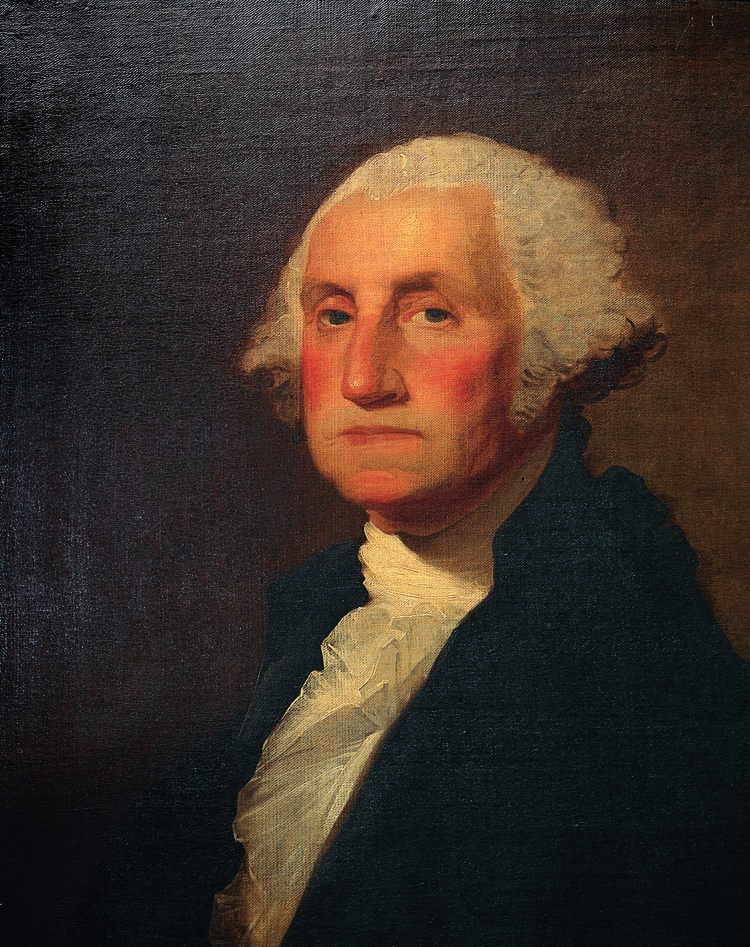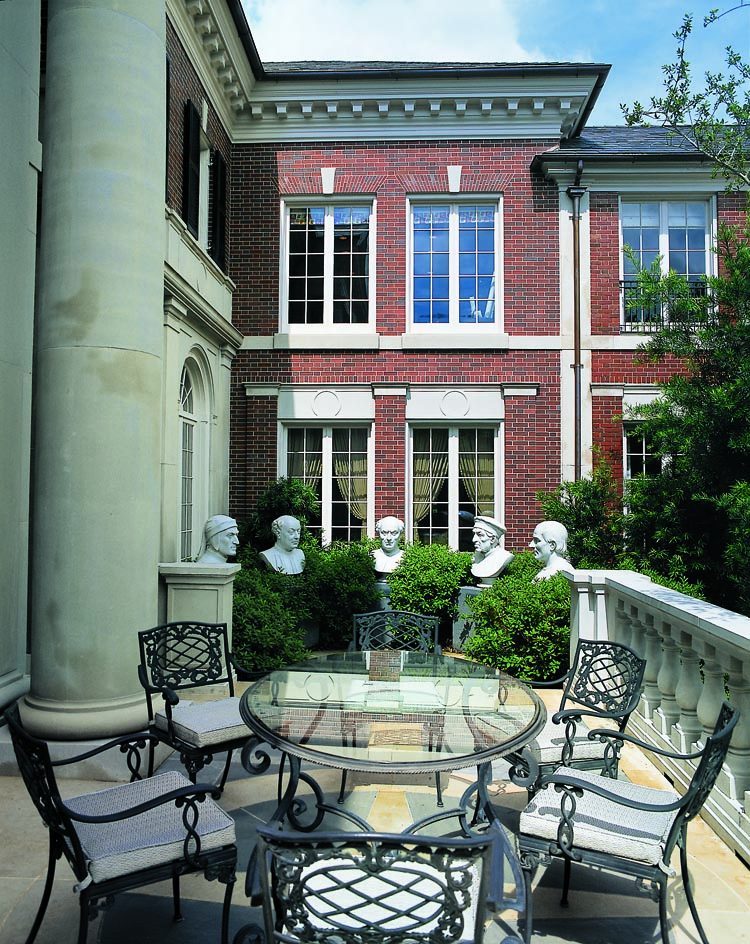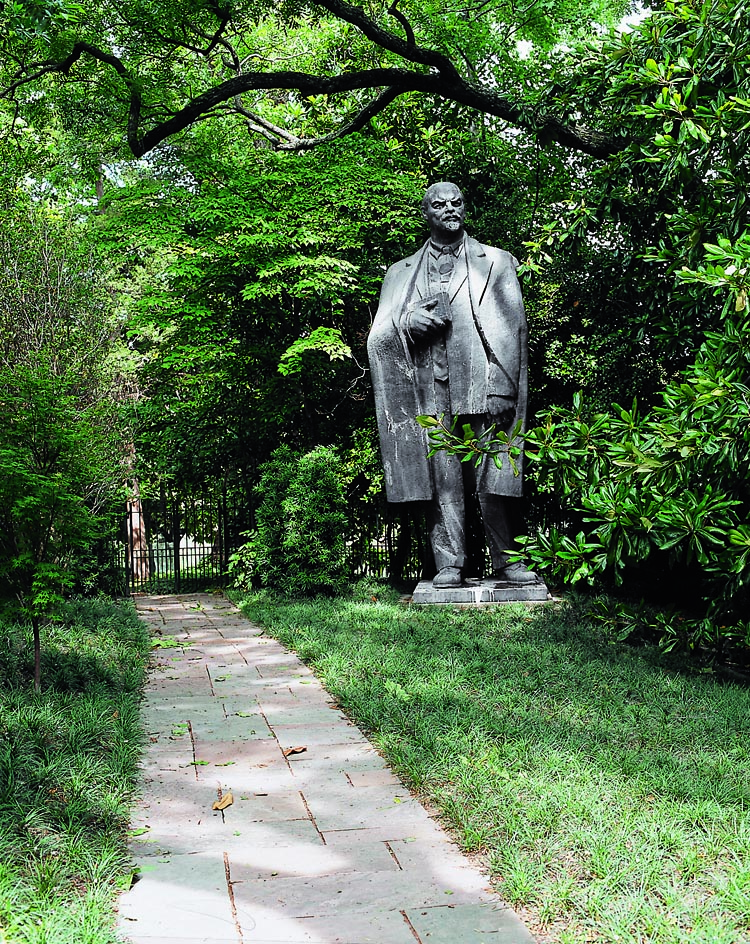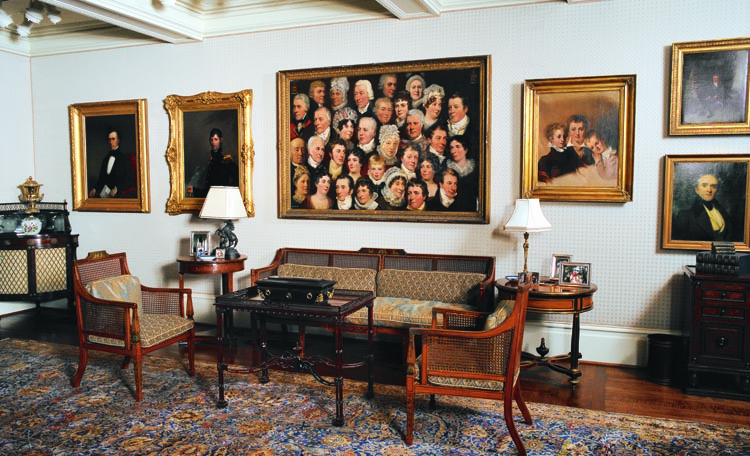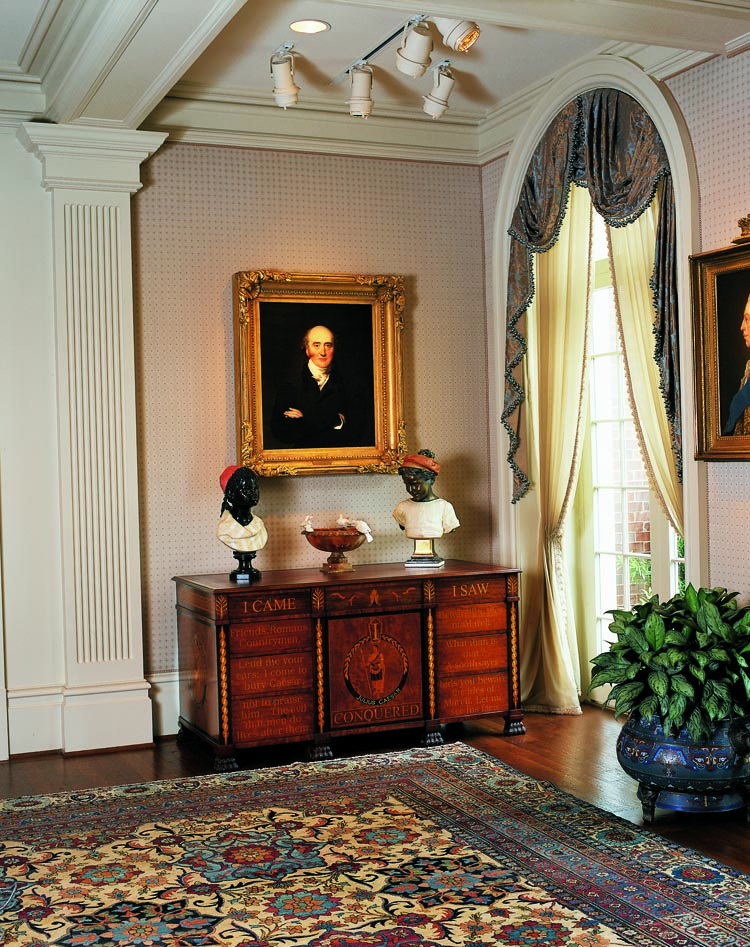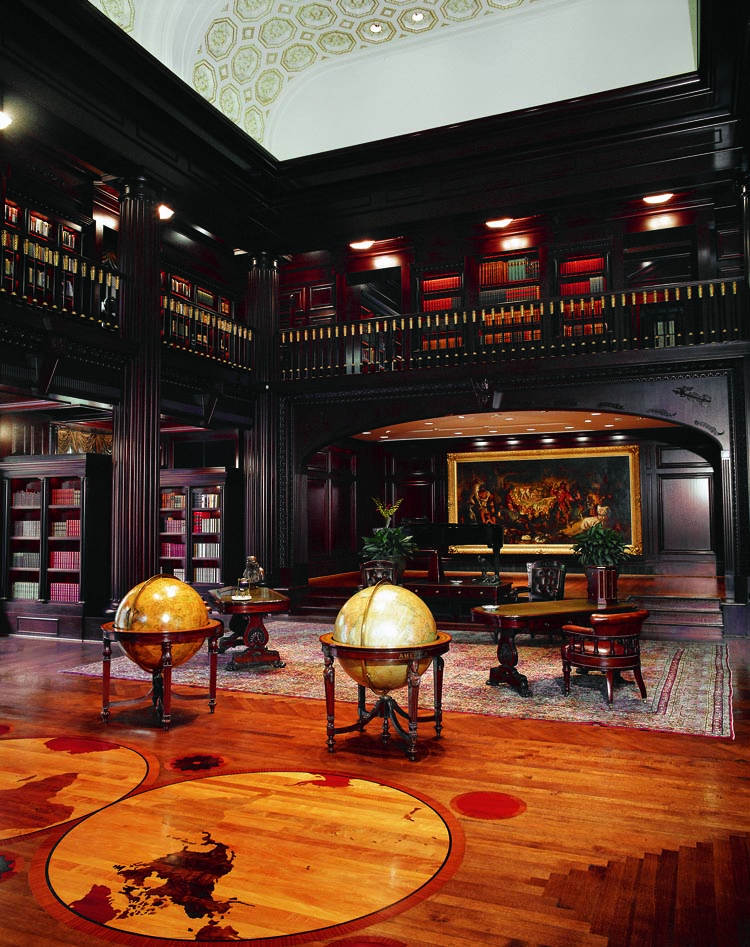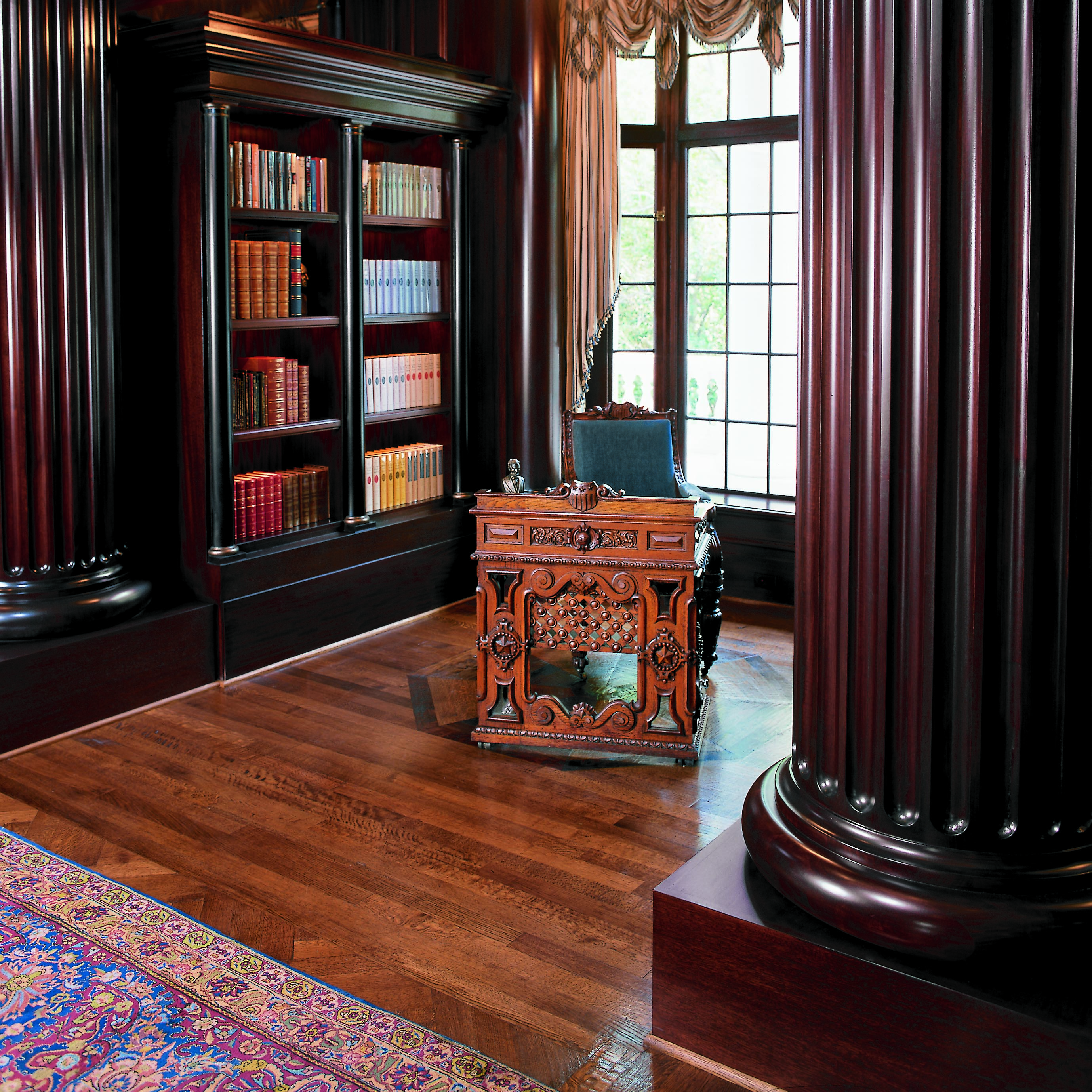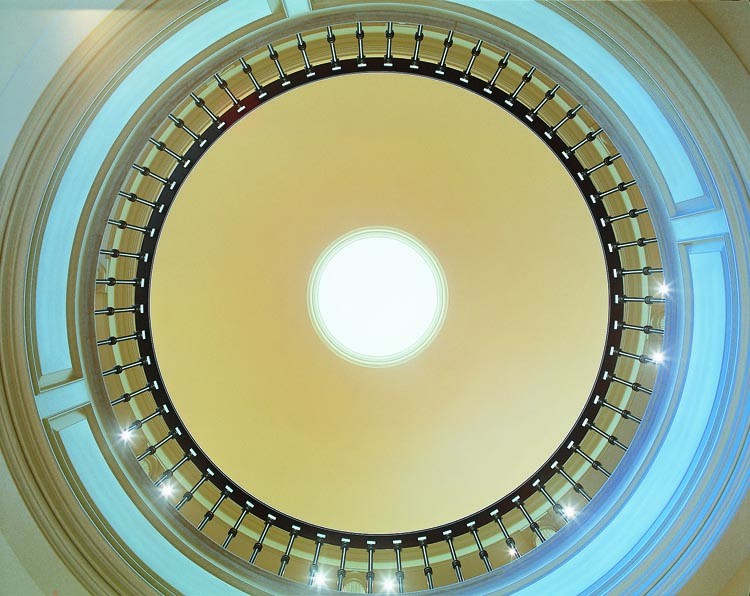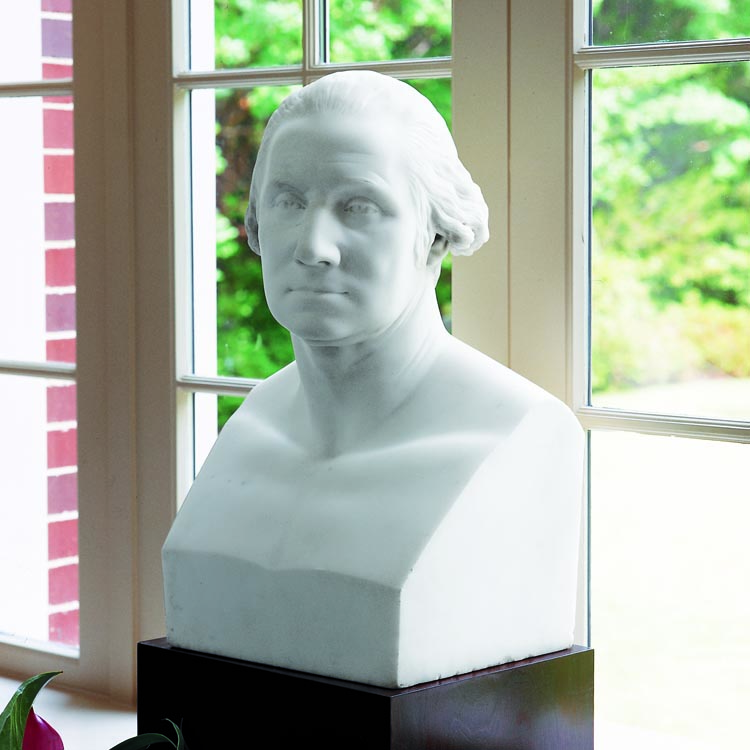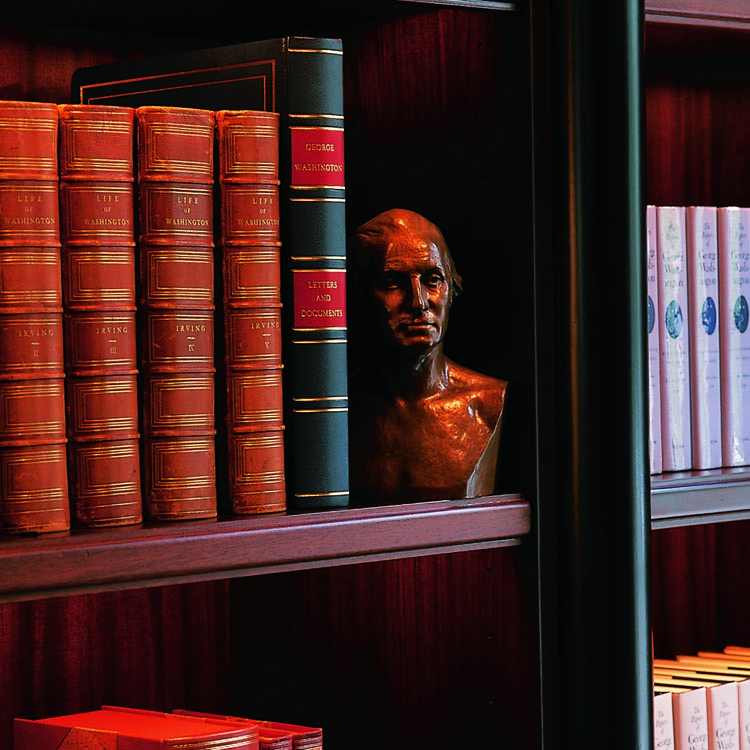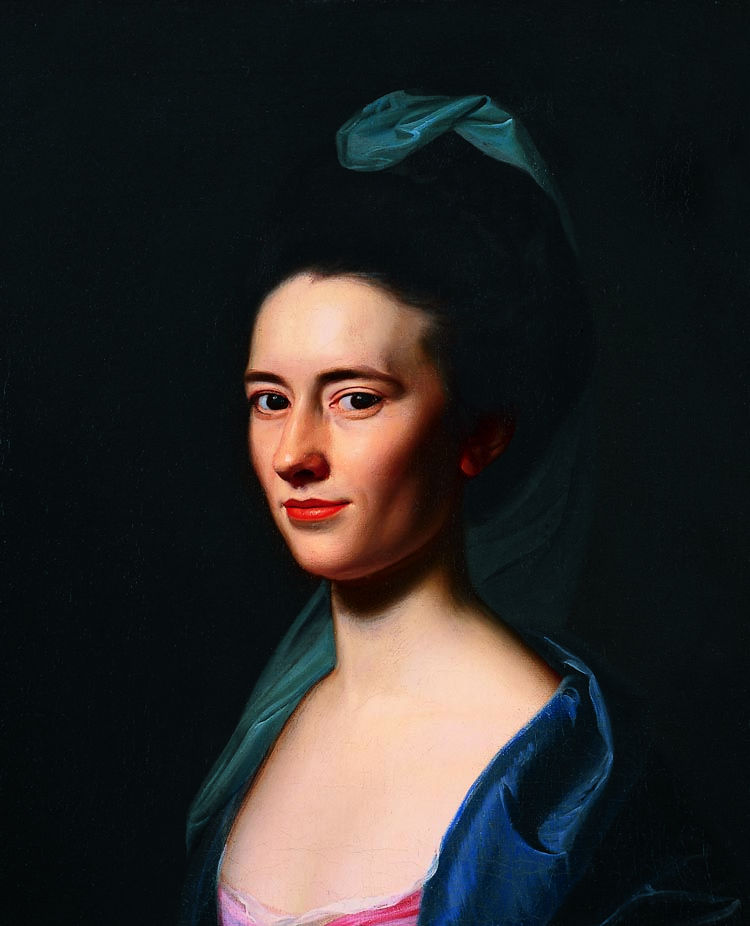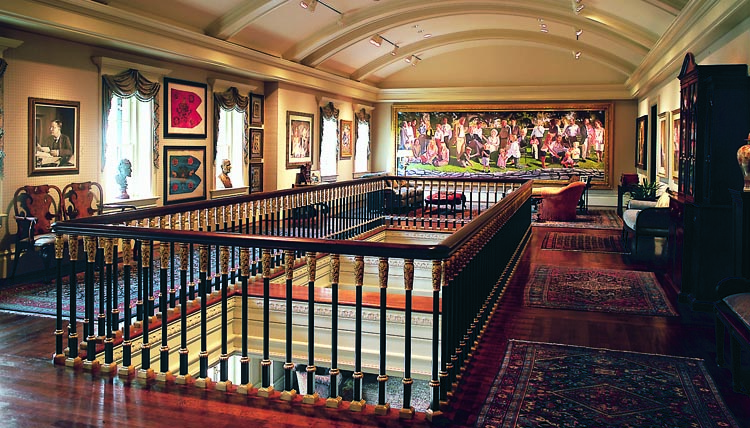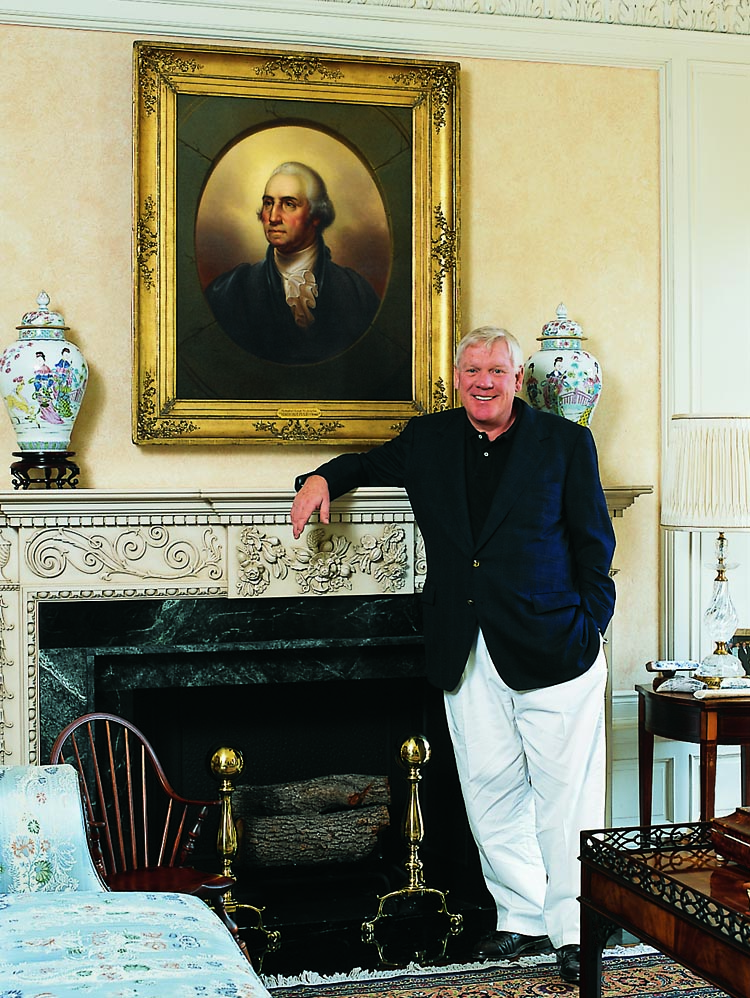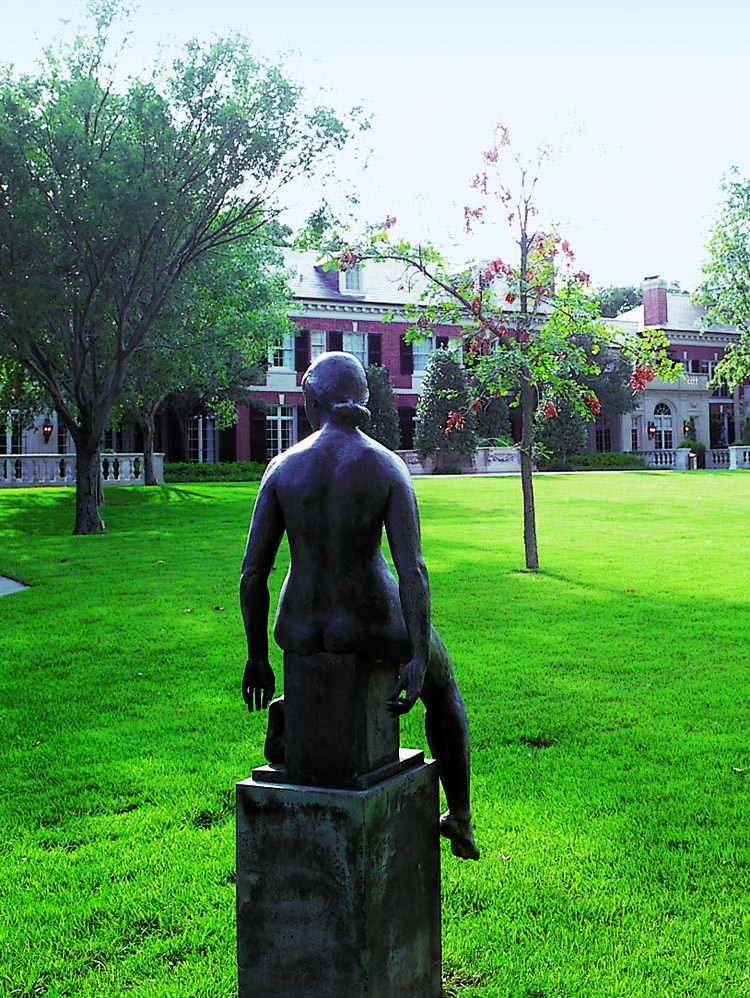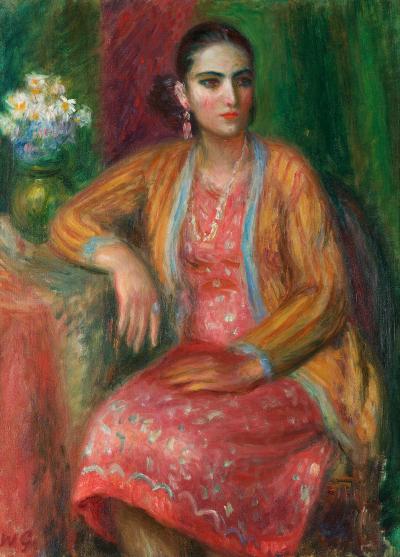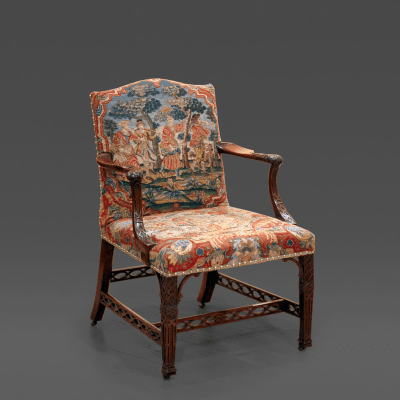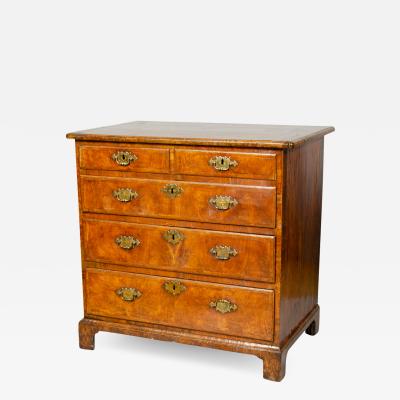American Pantheon
A Neo-Georgian Estate Honors National Heritage
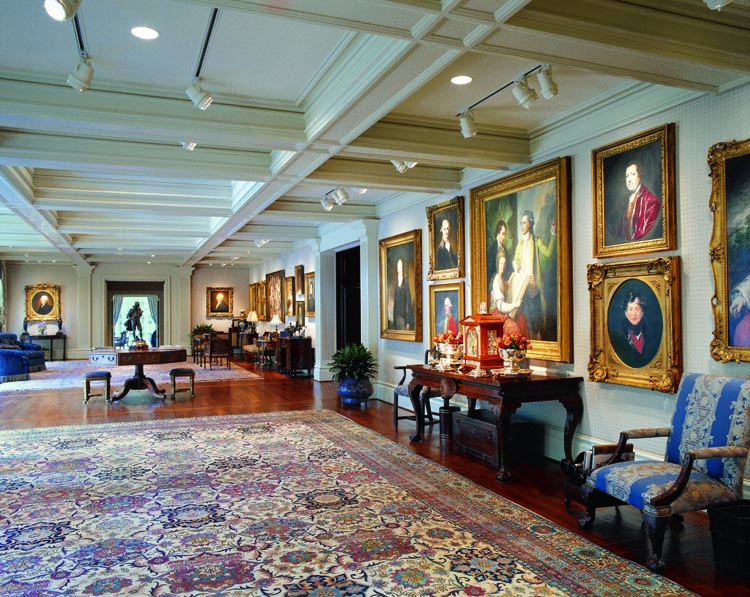
- The formal portrait gallery includes 18th- and 19th-century American and British political icons including Rt. Hon. Charles Townshend (shown upper right), 1765–1766, by Sir Joshua Reynolds (the sitter’s parliamentary action resulted in the Townshend Act which imposed taxes on colonial imports, and led to the Boston Tea Party). An Irish George III octagonal library table displays a bronze sculpture of an Arabian hunter cast from a model by Pierre-Louise Detrier, ca. 1880.
Cloaked by leafy oaks on the outskirts of Dallas, an ambitiously scaled building project was quietly inaugurated last spring. At its core is the gracious and relaxed family residence of Harlan and Kathy Crow. Their early twentieth-century Georgian Revival mansion has been extended with a new south wing housing collections of great historical significance.
Formal galleries are filled with portraits depicting English nobility and American patriots by colonial-era masters from Joshua Reynolds to Gilbert Stuart. Carefully curated by Harlan Crow, a vast assemblage of autographs, manuscripts, political memorabilia, antiques, sculpture, and decorative arts constitutes a comprehensive overview of the birth of American democracy.
“I am a very tenacious acquirer,” Crow admits of his thirty-year collecting saga. He has continually sought out the best material available from art galleries and auctions from London to New York. Unassuming and genteel in manner, Crow is also noted for his formidable real estate ventures and commercial property developments around the globe.
While still very much part of a private residence, the Harlan Crow Library and Gallery is a national treasure of enormous depth and value. In the footsteps of Henry Frick, J. P. Morgan, and H. E. Huntington, Crow collects with an eye toward the future public enjoyment of his personal collection. The fireplace mantel of one of his homes is inscribed with words he lives by, “For unto whomsoever much is given, of him shall much be required.” (Luke 12:48)
Within integrated brick, limestone, milled woodwork, and carved architectural elements, Crow’s repository of rare objects has been established to perpetuate the Founding Fathers’ reverence for the civic virtues and democratic values of the Enlightenment. The collection’s focus celebrates “the majesty of their ideas,” says Crow.
Over the course of five years working on the library project, architect Richard Giegengack grew to appreciate not only Crow’s design input, but also his respect for craftsmanship.
In the spirit of architect-President Thomas Jefferson’s building of Monticello, this Texas collector was thoroughly involved with the construction of his patriotically inspired hall of heroes. He feels as Jefferson stated, “Architecture is my delight…one of my favorite amusements.”1
The south wing’s architectural details include gentle nods to the colonial language of Peter Harrison and the Adamesque elements favored by Charles Bulfinch. Jefferson’s early republic classicism is carried in the Tuscan order throughout. This rigid classicism exhibits a few romantic interior flourishes, such as the painted cartouches set within highly stylized rococo plaster frames.
“Every nuance of American architecture of the eighteenth and early nineteenth centuries impacted the final design,” Giegengack notes of the harmonious combination of elements. “The end result is serenity. One feels transported to a domestic utopia.”
Interior designer John Phifer Marrs of Dallas also responded to the Crow family’s stated desire to maintain the feeling of a comfortable home. He chose sophisticated but livable fabrics. Recognizing that hooks for heavy paintings would ultimately damage the wall coverings, Marrs selected a silver-gray pin-dot pattern to disguise future reinstallations.
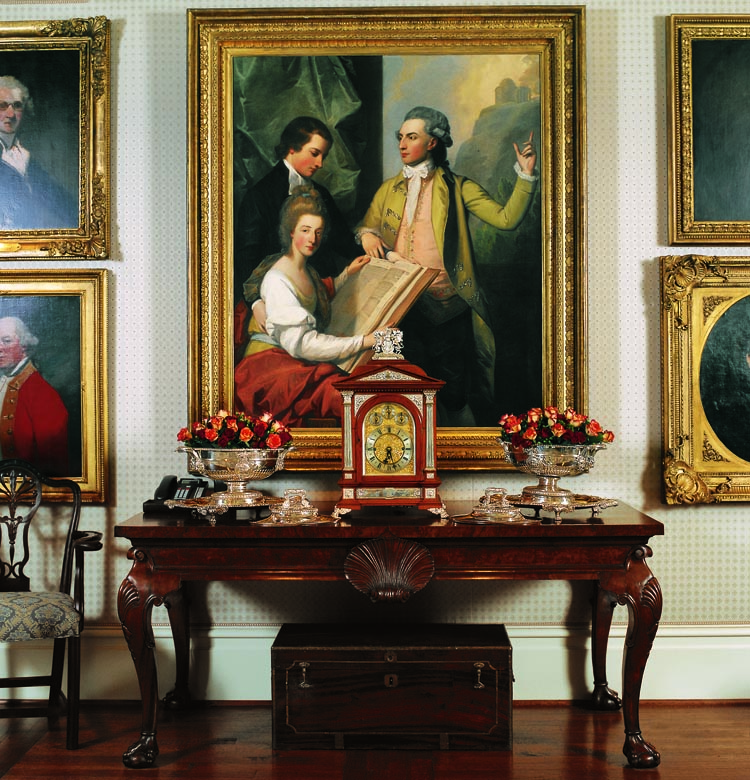
- A pair of George III silver soup tureens double as floral displays in the gallery. The neoclassical clock is inscribed: Presented by King George V to King Abdul Aziz al Saud. American expatriate painter Benjamin West’s Three Members of the Drummond Family (1781) hangs above. West is entombed in Westminster Abbey beside his royal patron and friend, King George III.
Crow’s octagonal office reflects an uncompromising federal character, accented with period silver, porcelain, and furniture in the tradition of the dazzling elegance of the Diplomatic Reception Rooms in the U.S. State Department building. Crow, a frequent guest inside Washington’s political corridors, has an intuitive understanding of the architectural lexicon of power.
Measuring over twenty feet in length, antique Agra and Kirman carpets blanket the formal portrait gallery. Here we encounter the citizens, philosophers, and political thinkers of Anglo-American colonial times.
Artists of the period were often guided by physiognomy, the theory that temperament and character are reflected in an individual’s appearance. More than any other colonial figure, George Washington was idolized by his countrymen. Artists depicting this legend sought to convey his upright and sterling character. “Everything in his face announces the good man, of simple manners, sincere, firm, reflecting and generous,” noted a contemporary essayist.2
Four signature portraits of Washington form the nucleus of the gallery. Gilbert Stuart’s 1798 Rawle-Carnill Portrait is among the seventy-two known variations he made of his unfinished original oil of Washington, painted from life in 1796. In the collection of the Boston Athenaeum for about 150 years, the original was regarded to be such a truthful likeness that Stuart used it again and again as inspiration for additional Washington commissions; these variations are known as Athenaeums. (The original is now jointly owned by the Museum of Fine Arts, Boston, and the National Portrait Gallery, Washington, D.C.)
Stuart’s client William Rawle, United States District Attorney for Pennsylvania under Washington, commissioned the painting in Crow’s collection. The work was identified in Eisen’s Portraits of Washington (1932), a guide that distinguishes the subtle differences in the Washington Athenaeums, as having six variations from the original, including “coarse linen...folds [that] radiate from the center… hair bag plain, ridgelike with a small bay in the margin.”3
The second Washington portrait in the collection is a later work based on Stuart’s Athenaeum original. Painted in 1857 by Rembrandt Peale of Philadelphia, over sixty years after the Stuart original, it demonstrates how the next generation imitated Stuart’s method of using small brushstrokes of overlapping color to create an effect in which colors are mixed in the retinal experience of the viewer.4
A third iconic Washington image has a distinguished provenance that includes collector John Wanamaker and Kennedy Galleries in New York. In a gilded period frame, this Rembrandt Peale incarnation of Washington casts him in a sacred light, illuminated with a heavenly ray. Known as a porthole portrait, the composition contains a trompe l’oeil illusion of a porthole around the reliquary image of a deified Washington. This work was painted in 1859 on the eve of the Civil War, when patriotism was running high.
Rounding out Crow’s quartet of Washington likenesses is the Goldsborough-Frelinghuysen Portrait by Charles Willson Peale. The paterfamilias of the nation’s first dynasty of artists that included the aptly-named Rembrandt Peale and sixteen more children by three wives, C. W. Peale viewed himself as a citizen-patriot who created historical paintings.
The portrait’s original owner, Judge Robert Goldsborough, hosted Peale at his home in Myrtle Grove, Virginia, twice in 1789 and again in 1791; the portrait dates from that period. In this painting, Washington is clad in his Virginia militia uniform; his gold-braided epaulets are depicted with great attention to detail. Peale’s biographer, Charles Coleman Sellers, was especially impressed by the portrait, believing this representation “stood out as the only one with genuine humanity, even a twinkle in the eye.” 5
The picture gallery is interspersed with Irish George III furniture and portraits of British aristocrats of the eighteenth and nineteenth centuries. Art dealer Philip Mould of Historical Portraits in London notes, “Harlan has imaginatively collected English society portrait painters of genius not normally considered by an American historical collector.”
Judiciously selected works by Royal Academy luminaries Thomas Gainsborough, Joshua Reynolds, and Thomas Lawrence have been handsomely installed. “I am especially fond of Lawrence’s 1827 depiction of Prime Minister George Canning,” Crow says. “From my perspective, the treatment of eyes and hands is the real litmus test of a great portraitist, and Lawrence really captures the forceful essence of the great man.”
American expatriate painters Benjamin West and John Singleton Copley are also represented. Three Members of the Drummond Family, 1781, signed B. West, depicts the brother and sister of Robert Auriol Drummond, archbishop of York. This impressively scaled canvas (60 by 51 inches) is wonderfully preserved in its original eighteenth-century Carlo Maratta frame. Although the composition is rigid, West, a Pennsylvania Quaker by birth, neatly intertwines the English family into a proto-romantic landscape capped with a small temple of reason on an Arcadian hilltop.
Also in the picture gallery, Copley’s 1771 portrait Frances Montresor captures one of colonial New York’s most enchanting hostesses. During this period, prior to his departure for England, Copley eschewed fanciful accoutrements such as parasols, bird cages, or polished wood surfaces, and focused on figures posed against dark backgrounds for a dramatic effect. This work was painted during a triumphant upswing in Copley’s career. His social and commercial success is recorded in Flexner’s seminal account: “Copley made his first long journey [from Boston] to New York. He stayed six months, painting about seven hundred pounds worth of portraits. The most substantial people flocked into his studio, and even those who had been abroad, he boasted, said his were the best pictures they had ever seen.”6
The adjoining library wing, a soaring, coffered great hall, contains over 5,600 rare autographs, manuscripts, parchments, and signed photographs. Nearly all of the forty-three U.S. presidents are represented, and there is a remarkable depth in material related to George Washington, Thomas Jefferson, and Abraham Lincoln.
Signers of the Declaration of Independence and framers of the Constitution such as John Adams, Benjamin Franklin, John Hancock, and Alexander Hamilton are represented in a hoard of personal notes and formal letters, all handsomely archived in custom-bound leather portfolios.

- Multiple generations of the Crow family are presented in a panoramic image by Minnesota-based fresco and tempera master Mark Balma. A sweeping tempera measuring 91 by 242 inches, the mural echoes Italian Renaissance frescoes such as Mantegna’s work of the Gonzaga family dynasty at the Ducal Palace in Mantua. Installed as the visual capstone for the mezzanine level, this work weaves the Crow family legacy into the library’s narrative of Texas and U.S. history.
Letters penned by Supreme Court members trace the opinions of notables from John Jay and Oliver Wendell Holmes to contemporary justices Sandra Day O’Connor and Ruth Bader Ginsburg. British royal, American Revolution, Civil War, and general military history come alive in the correspondences of King George III, General Cornwallis, the Marquis de Lafayette, Santa Ana, Jefferson Davis, Robert E. Lee, Ulysses Grant, George Armstrong Custer, George S. Patton, Admiral Nimitz, and many others.
The document collection contains a first edition of the much sought-after “Columbus Letter.” Printed in Rome on April 29, 1493, this firsthand account of Columbus’s 1492 voyage of discovery was translated from his letter to the Spanish court. The Crow copy is the only version in private hands in North America; eleven other copies are located in institutional libraries in the U.S. such as the New York Public Library and twelve more are in European collections including the Vatican’s.
Additional historical items range from Napoleon’s writing desk to Admiral Byrd’s navigational instruments for an Antarctic expedition. There is also the Texas state flag brought to the moon on one of the Apollo missions.
Texas history is a prominent part of the collection as well, especially when there are family ties to notable events. In November 1963, President John F. Kennedy’s motorcade was scheduled to arrive for a luncheon at the newly constructed Dallas Market Center, then the jewel in the crown of the commercial properties developed by Harlan’s father, Trammell Crow. The legendary real 0estate developer and diversified investor never had the opportunity to host his guests that fateful day. Among the documents in Harlan Crow’s collection is a copy of Lee Harvey Oswald’s police arrest certificate. Several related letters offer a somber footnote to the library’s contents.
While an avid collector of national heritage objects, Crow is humble about his custody of what is perhaps the finest private assemblage of papers and artifacts celebrating American democracy. With his library and gallery, Crow has created an American temple of treasures reflecting a reverence for those who catalyzed the development of democratic ideals.
Philip Eliasoph is professor of art history at Fairfield University, Connecticut. He specializes in the Italian Renaissance fresco and egg-tempera methods adopted by classically inspired American artists. An independent collections advisor for private clients, he has authored several monographic exhibition catalogues featuring American realists.
This article was originally published in the Autumn 2004 issue of Antiques & Fine Art magazine (established 2000), which is affiliated with InCollect.com (launched in 2014).
1. Jack McLaughlin, Jefferson and Monticello: The Biography of a Builder, (New York: Henry Holt & Company, 1988), 373.
2. Johann Caspar Lavater, Essays on Physiognomy, designed to promote the Knowledge and Love of Mankind. Edited by Thomas Holloway. 3 vols. (London, 1789– 1798).
3.Gustavus A. Eisen, Portraits of Washington (New York: R. Hamilton & Associates, 1932), vol. I, 179.
4.Richard McLanathan, Gilbert Stuart (New York: Harry N. Abrams, 1986), 143.
5.Charles Coleman Sellers, Portraits and Miniatures by Charles Willson Peale (Philadelphia: American Philosophical Society, 1952), 358.
6.James Thomas Flexner, America’s Old Masters (New York: Doubleday, reprinted 1980), 133.















